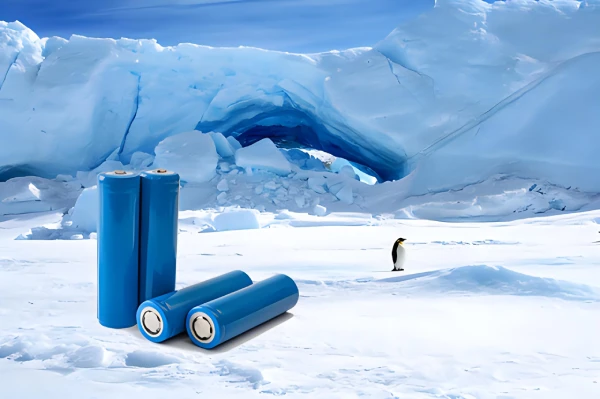Ordinary lithium batteries may not be usable at -20°C, but low-temperature lithium batteries can still be used normally at -50°C. Low-temperature lithium batteries have the advantages of being lightweight, high specific energy, and long life. They are widely used in various electronic devices. Among them, low-temperature polymer lithium-ion batteries also have the advantages of simple packaging, easy to change the geometry of the battery, ultra-light and ultra-thin, and high safety, becoming the power source of many mobile electronic products.
Part 1. What types of rechargeable low-temperature lithium batteries?
When using digital devices, sometimes the lithium battery suddenly runs out of power when it encounters low temperatures, even if it has just been fully charged. This is because lithium batteries are affected by temperature. So, which kind of battery is not afraid of cold? This is exactly the main goal of this paper: low-temperature resistant lithium batteries.
Part 2. What is a low-temperature lithium battery?
In a general sense, most of what we see in our daily lives are chemical batteries. These chemical batteries lose activity at low temperatures. This results in their working performance being reduced or even unable to work under low temperature conditions.
So, which battery is not affected by temperature?
Part 3. Types of low temperature lithium battery
Suppose low-temperature-resistant compounds are added to ordinary chemical batteries. In that case, the battery can no longer fear low temperatures. Low-temperature lithium polymer batteries, low-temperature 18650 lithium batteries, and low-temperature lithium iron phosphate batteries are commonly used low-temperature batteries on the market.
According to different classification methods, low-temperature lithium batteries also have the following types.
1. According to discharge performance, it is divided into energy storage type low-temperature lithium battery and rate type low-temperature lithium battery.
Low-temperature energy storage lithium batteries are widely used in special tablet computers, paratrooper equipment, special navigators, UAV backup starting power supplies, special flight instrument power supplies, satellite signal receiving devices, ocean data monitoring equipment, atmospheric data monitoring equipment, outdoor video Identification equipment, oil exploration and testing equipment, railway monitoring equipment, power grid outdoor monitoring equipment, special warm shoes, vehicle backup power supply.
Low-temperature rate lithium batteries are used in infrared laser equipment, strong light armed police equipment, and acoustic armed police equipment.
2. Low-temperature lithium batteries are divided into military low-temperature lithium batteries and industrial low-temperature lithium batteries according to their application fields.
3. According to the low-temperature use environment, it can be divided into -20℃ civilian low-temperature lithium batteries, -40℃ special low-temperature lithium batteries, and -50℃ extreme environment low-temperature lithium batteries.
4. their use environment divides them into civilian low-temperature batteries, special low-temperature batteries, and extreme environment low-temperature batteries.
- Civilian low-temperature lithium battery: -20℃ battery discharge at 0.2C accounts for more than 80% of the rated capacity. The 0.2C discharge of the battery at 30℃ accounts for more than 50% of the rated capacity.
- Special low-temperature lithium battery: -40℃ battery discharge at 0.2C accounts for over 80% of the rated capacity. At 50°C, the battery’s 0.2C discharge accounts for over 30% of the rated capacity.
- Low-temperature lithium batteries in extreme environments: The battery’s 0.2C discharge accounts for over 50% of the rated capacity at -50°C.
Part 4. What materials inside lithium batteries affect the low-temperature performance of the battery?
1. Lithium battery cathode materials
The cathode material as a power source is one of the main parameters affecting the low-temperature performance of lithium batteries. Currently, the mainstream material systems on the market are ternary materials and lithium iron phosphate materials. The two materials have better low-temperature performance than ternary.
The low-temperature performance of lithium iron phosphate is mainly due to the fact that the material itself is an insulator with low electronic conductivity, poor lithium ion diffusivity, and poor conductivity at low temperatures. This increases the internal resistance of the battery, greatly affects the polarization, and hinders the charging and discharging of the battery, so the low-temperature performance is not ideal. The material greatly affects the insertion/extraction of lithium ions between the positive and negative electrodes at low temperatures. The ternary material has a layered structure and a high material diffusion coefficient, which is more conducive to the insertion/extraction of lithium ions.
The structure, particle size, and type of material greatly influence lithium batteries’ low-temperature performance.
The small particle size and large specific surface area of the cathode material are conducive to low-temperature performance. The smaller the particle size, the shorter the lithium-ion diffusion path, and the smaller the polarization. At the same time, the electrolyte also easily adheres to the surface of the original particles, reducing concentration polarization.
The larger the particle size, the longer the path for lithium ion diffusion. When the battery is operating and discharging, the diffusion of lithium ions from the negative electrode to the positive electrode has no time to compensate for the electrons flowing from the negative electrode to the positive electrode. This causes an excess of electrons in the positive electrode, causing the electrode potential to shift negatively, causing the discharge voltage platform to become lower.
In addition to the properties of the material itself, parameters such as the dispersion of the conductive agent in the cathode slurry, bonding properties, electrode surface density, and active material density also have an important impact on low-temperature performance.
The conductive agent is evenly dispersed without aggregation, which can improve the conductivity of lithium-ion batteries and reduce the ohmic internal resistance of lithium-ion batteries. This helps improve the battery’s charge and discharge performance.
The greater the surface density, the greater the ion diffusion distance and resistance. The distance from the solid-liquid interface where the electrode surface is in contact with the electrolyte to the current collector increases. To maintain the electrode charge balance when lithium ions are deintercalated, the resistance to the transfer of migrating electrons between the two also increases. The deviation between the electrode and equilibrium potentials is greater, the battery polarization is increased, and its low-temperature performance is naturally not very good.
2. Lithium battery electrolyte
The electrolyte’s material and physical and chemical parameters have an important impact on the low-temperature performance of the battery.
The problem faced by lithium batteries when cycling at low temperatures is that the viscosity of the electrolyte increases, the ion conduction speed slows down. The electron migration speed in the external circuit does not match, the battery becomes severely polarized, and the charge and discharge capacity decreases sharply.
Especially in the case of low-temperature charging, lithium ions can easily form lithium dendrites on the surface of the negative electrode, causing battery failure.
The low-temperature performance of the electrolyte is closely related to the conductivity of the electrolyte itself. Those with high conductivity can transport ions quickly and exert more capacity at low temperatures. The more lithium salts in the electrolyte are dissociated, the greater the number of migrations and the higher the conductivity.
The conductivity is high, and the faster the ion conduction rate is, the smaller the polarization is, and the better the battery performance is at low temperatures. Therefore, higher conductivity is necessary for achieving good low-temperature performance of lithium-ion batteries.
The conductivity of the electrolyte is related to the composition of the electrolyte. Reducing the viscosity of the solvent is one of the ways to improve the conductivity of the electrolyte. The good fluidity of the solvent at low temperatures ensures ion transport. The solid electrolyte film formed by the electrolyte on the negative electrode at low temperatures is also the key to affecting lithium ion conduction.
Therefore, to improve the conductivity of electrolytes at low temperatures, we can start from the following two points.
- The solution has a low freezing point
- SEI film with low internal resistance
3. Lithium battery separator
The impact of the separator on the low-temperature performance of lithium batteries is mainly the impact of its resistance on battery performance at different temperatures. The size of the pores has a direct impact on battery performance. Too small aperture will increase the internal resistance of the battery. If the pore size is too large, the positive and negative electrodes may be in direct contact or pierced by lithium dendrites, causing a short circuit in the battery.
Appropriate porosity is particularly important for the performance of separators and batteries. Suppose the porosity of the separator is too small. In that case, the separator will have poor air permeability, weak electrolyte adsorption capacity, and low conductivity. Suppose the porosity is too high, although the breathability and electrolyte adsorption capacity are significantly improved. In that case, the corresponding shrinkage and puncture resistance will become worse.
In addition to the materials listed above, factors that affect the low-temperature performance of lithium batteries include the battery production process, formation system, aging system, etc.
The low-temperature cycle performance of lithium batteries can be improved by reducing internal resistance and the low-temperature polarization of lithium batteries.
Part 5. Advantages of Ufine low-temperature lithium battery
- High low-temperature discharge performance. Discharge at a minimum of 0.2C at -50°C, with an efficiency of over 60%. In -40℃ environment, discharge at 0.2C, the discharge capacity reaches 80%;
- Wide operating temperature range. -50°C to 50°C;
- Excellent low-temperature cycle performance. Charge and discharge at 0.5C in a -30°C environment, and the capacity remains above 85% after 300 cycles;
- Safety. Passed UL/CE/UN certification;
- Flexible size. The size and shape of the lithium battery can be customized according to customer needs;
- Compared with traditional lithium polymer batteries, it breaks through the discharge temperature limit of -20℃~60℃.
- It has the capability of mass production, and the battery has good consistency;
- It can generate large current at -50℃ and maintain large capacity;
- It can still maintain its excellent performance in a working environment of -50℃;
- 10 Can be widely used in cold climates and special equipment.
Related Tags:
More Articles

Top 10 Deep Cycle RV Batteries for Reliable Power
Looking for a reliable deep-cycle RV battery? Check out our guide on the top 10 best deep-cycle RV batteries to power your needs this year!
Top 10 High-Performance Batteries for High-Drain Devices
Are you looking for a high-performance battery that you can rely on for a high-drain device? Here are the top 10 best batteries for high-drain devices.
The Basics of Industrial Batteries: A Quick Overview
Learn what industrial batteries are and how they power machines. Discover their types and uses to boost your operations today.
Top 10 Lithium Motorcycle Batteries for Optimal Performance
Looking for a reliable Lithium motorcycle battery for optimal performance? Here’s a guide with this year's top 10 best Lithium motorcycle batteries.
How Long Will a 100Ah Lithium Battery Last?
Wondering how long a 100Ah lithium battery lasts? Get clear answers and tips for efficient use. Click now to learn more!




